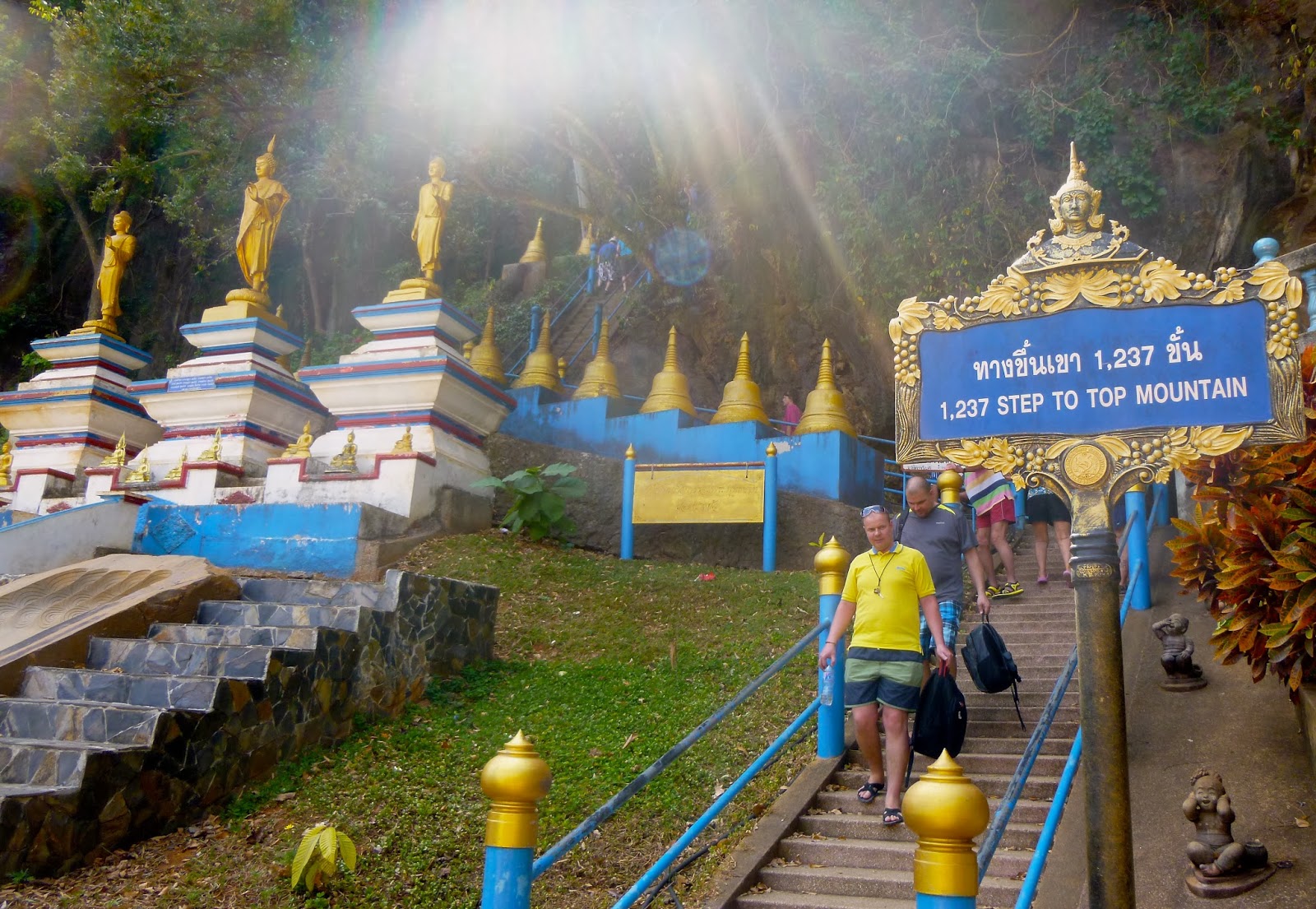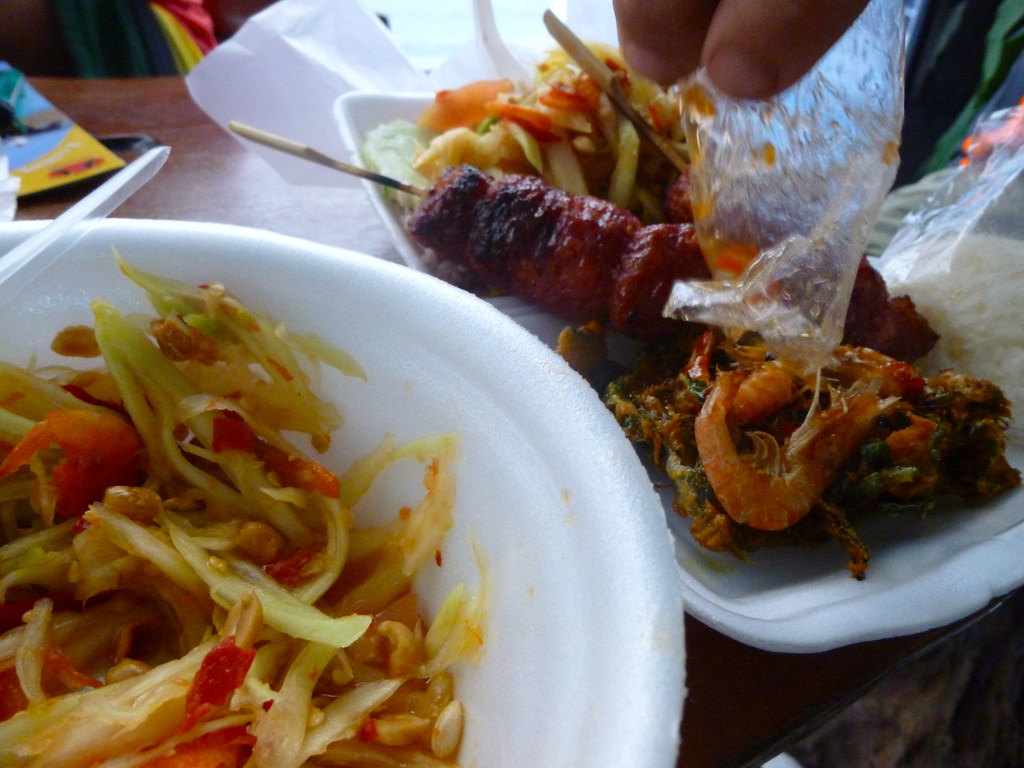 |
| 1237 steps to the top of the Tiger Cave Temple |
13 February – 18 February
The Tiger Cave Temple is the one thing
I was sure I wanted to visit in Krabi. I think it's good for a
traveler to give herself a rest now and then, especially from doing
things at a breakneck pace. It is an exhausting business, jumping
from boat to open-backed truck to bus, day after day, as many
travelers must do, to keep to a rigid itinerary, or for fear that if
they remain where they are they'll miss something essential in the future. So I took my time in Krabi, taking a full day to
discuss my intended route to the temple with various Thais, including an iced-latte barista.
Conversations like these, in which I am
generally trying to plumb the depths of an arcane and unknown
public-transit system, allow me to experiment with a lot of new vocabulary. The barista said that the Tiger Cave is not generally
crowded with farangs, especially if I avoided the weekend, but it was
already Friday when I asked, and far too much of the afternoon had
passed. Giving me an excuse to stay put. The next day I quizzed an
open-backed truck (sohngtaeou) driver about the price. And
Monday, we finally went.
 |
| No seatbelts. The way this lady is looking at me is the way most people do when I whip out the camera. |
In the meantime, I ate. Krabi, as it
turns out, has a spectacular day market. I have recently posted some
photographs of pleasant things I sampled. But I find myself effusing
about them as I look at the pictures. The more time I spend in Thailand, the more I remember what a food culture it is. Or maybe it's just the part of culture I appreciate most.
Bringing of food to the table is
something that's celebrated. The soup vendors we go to our artists.
They've mastered some of these arts—making perfect stock, for
instance—and they get to spend their lives in service to that art.
I find myself agreeing with Ira Sukrungruang:
“[Thais] say there is no better cuisine on the
planet, that no other country has a dish that can be salty, sour,
sweet all at once...”
I'm also beginning to realize how
distant many other tourists feel from the street food, how they feel
unable to make themselves understood, or even where to begin, and
what a gift that has been to us, both in terms of our budget and our
cultural immersion. More often now we have the courage to stop and
point at something and sample it, even when we've never tried it
before, even when we have no idea how to eat. I say: tam yangai?
How do we do it? And we're shown.
 |
| Eesan sausage, som tahm, and shrimp cakes |
Eesan sausage: Sour and spicy and
grainy with cartilagy chunks—Thailand is brilliant in fried pork
fat. Things I'd normally consider gross dissolve in my mouth with
toothsome deliciousness. I ate a whole bowl of guiteau with pork
liver, and the gamey meatiness was almost delicious. I eat whole
chunks of pork fat that melt like well-fried bacon. Chicken feet I
still can't stomach.
Som tahm: green papaya salad, green
papaya like green mango, eaten sour and as a vegetable not a fruit.
A Thai national dish and I think the epitome of the
flavor-combination rule. For somtahm you add lime, palm sugar, fish
sauce, chili, and the fifth flavor too—bitter or umami—using
crushed peanuts or garlic or baby shrimp pounded in a mortar. We are
not brave or foolhardy enough to eat ours with pounded raw crab,
shell included like shards of glass. Som tahm is one of the world's
perfect foods.
 |
| Fried shrimp cakes |
Fried shrimp cakes (tod mun goong): K's
discovery. They are whole batter-fried clumps of shrimp, heads and
all, fried so the whole thing is equally crunchy, head as delicious
as tail. One thing I've had to learn to say in Thai: you can leave
the heads on. It's a mystery how we can eat things we'd never
eat otherwise—fish is deep-fried this way, too, with
edible bones. The only thing you can't eat with fish are chunks of
spine.
 |
| Note the ubiquitous Seven bag |
My perfect breakfast. Coconut bread
and tropical fruit. I had intended to eat exactly this menu every
morning, but coconut bread is harder to find than I expected, and
tropical fruit more expensive. Nevertheless we are convincing
ourselves to spend more money on fruit, and I am stunned as ever by
how spectacular it is. Mangosteen's flavor is undescribable. Lamyai
(longan) comes closest to pina colada. Dragonfruit taste like
custard studded with grit. Rambutan taste of sunshine.
The point being
that we made it to the Tiger Cave Temple. On Monday. It was worth
the wait.

2 comments:
When in Rome, eat like the Romans is what I always try to do. My stomach is rumbling!
Exactly... My stomach is rumbling, too. We haven't found shrimp cakes since Krabi.
Post a Comment